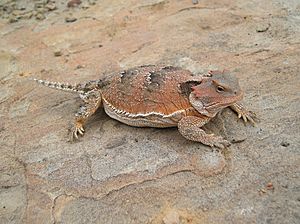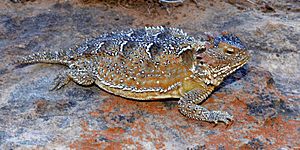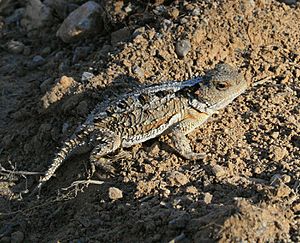Greater short-horned lizard facts for kids
Quick facts for kids Greater short-horned lizard |
|
|---|---|
 |
|
| Pregnant female greater short-horned lizard in the Mogollon Rim region of Payson, Arizona. | |
| Conservation status | |
| Scientific classification | |
| Genus: |
Phrynosoma
|
| Species: |
hernandesi
|
The greater short-horned lizard (Phrynosoma hernandesi) is a special type of lizard. People sometimes call it the mountain short-horned lizard. It lives only in western North America. Even though it's called a "horned toad," it's not a toad at all! It's a reptile, not an amphibian. This lizard is one of seven types of lizards found in Canada.
Contents
What's in a Name?
The scientific name for this lizard is hernandesi. This name honors Francisco Hernández de Toledo. He was a Spanish doctor who lived a long time ago. In 1615, he wrote one of the first descriptions of a horned lizard.
How to Identify a Greater Short-Horned Lizard
The greater short-horned lizard looks a lot like its cousin, the pygmy short-horned lizard (Phrynosoma douglasii). Both have small, pointed scales on their heads and backs. For a long time, scientists thought they were the same species.
Now, we know they are different. The pygmy short-horned lizard lives in the northwest United States and southern British Columbia. When fully grown, the pygmy short-horned lizard is much smaller.
Size and Appearance
Greater short-horned lizards are usually 2 to 5 inches (5.1 to 12.7 cm) long from their snout to their tail base. They have a flat, wide body and short spines on their head. Their nose looks a bit flat, and their legs are short.
They have a row of pointed scales along their sides. Their belly scales are smooth. These lizards can be gray, yellowish, or reddish-brown. They also have two rows of large dark spots on their backs. When they feel threatened, their colors become brighter.
Size Differences Between Males and Females
Female greater short-horned lizards grow larger than males. Females are about 2.75 inches (7 cm) long from snout to vent. They can reach a total length of about 6 inches (15 cm) and weigh about 18 grams.
Males are smaller, usually about 2 inches (5 cm) long from snout to vent. They weigh about 10 grams on average.
Lizard Behavior and Defense
These lizards are "sit-and-wait" hunters. They mainly eat ants. Sometimes, they will also catch a grasshopper or a beetle. You might find them sitting near an ant nest or ant trails.
They are active during the day, especially in the evening. At night, they burrow into the ground to sleep. They use their amazing camouflage to hide from predators.
Unique Defense Mechanism
If a greater short-horned lizard feels very threatened, it has a surprising defense. It can build up blood pressure behind its eyes. Then, it can accurately squirt blood at attacking predators! This blood tastes bad to animals like foxes, coyotes, and dogs.
It's very rare for them to squirt blood at humans. They save this special defense mostly for canids. This behavior has been seen in greater short-horned lizards, but not in pygmy short-horned lizards.
Reproduction and Life Cycle
The mating season for greater short-horned lizards is in the spring, usually from May to June. These lizards give live birth, which is called being viviparous. Females give birth to 5 to 48 babies between July and September.
The baby lizards are about 24 mm long from snout to vent. Each baby weighs about 1 gram. They don't have horns yet. Within a few hours, they can take care of themselves. They can fully crawl after about a day. Males can start having babies after their first year. Females usually wait two years before they reproduce.
Where Greater Short-Horned Lizards Live
The greater short-horned lizard is found across a very large area in North America. You can find them from central Nevada in the west to North Dakota and South Dakota in the east. They live as far north as southern Saskatchewan and Alberta in Canada. In the south, they reach the Texas Panhandle and central Mexico.
This lizard often lives in dry mountain areas. They can be found at high elevations, from about 170 to 3440 meters (9000–11,300 feet). It is the only type of Phrynosoma lizard in Wyoming. In fact, Phrynosoma is Wyoming's state reptile! However, in Saskatchewan and Alberta, this species is considered endangered.
Lizard Habitat
The greater short-horned lizard lives in many different habitats. These range from dry plains to high mountain areas. You can often find them in shortgrass prairies, sagebrush deserts, and juniper, pine, or fir forests.
The soil in these places can be stony or rocky. But it usually has fine, loose soil or sand too. This lizard can handle colder temperatures better than other lizard species. This allows it to live at higher elevations and in more places where it is cooler.




